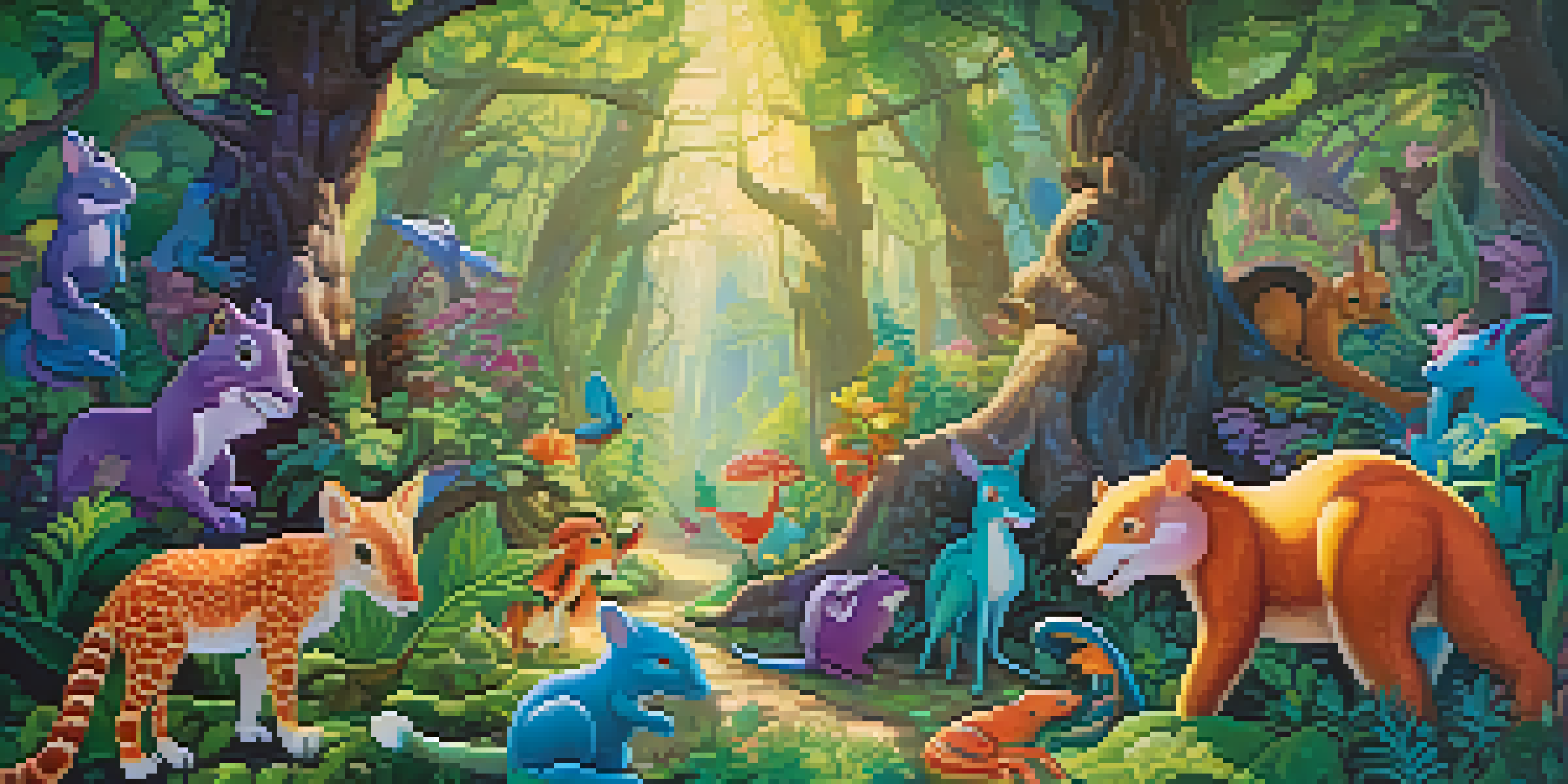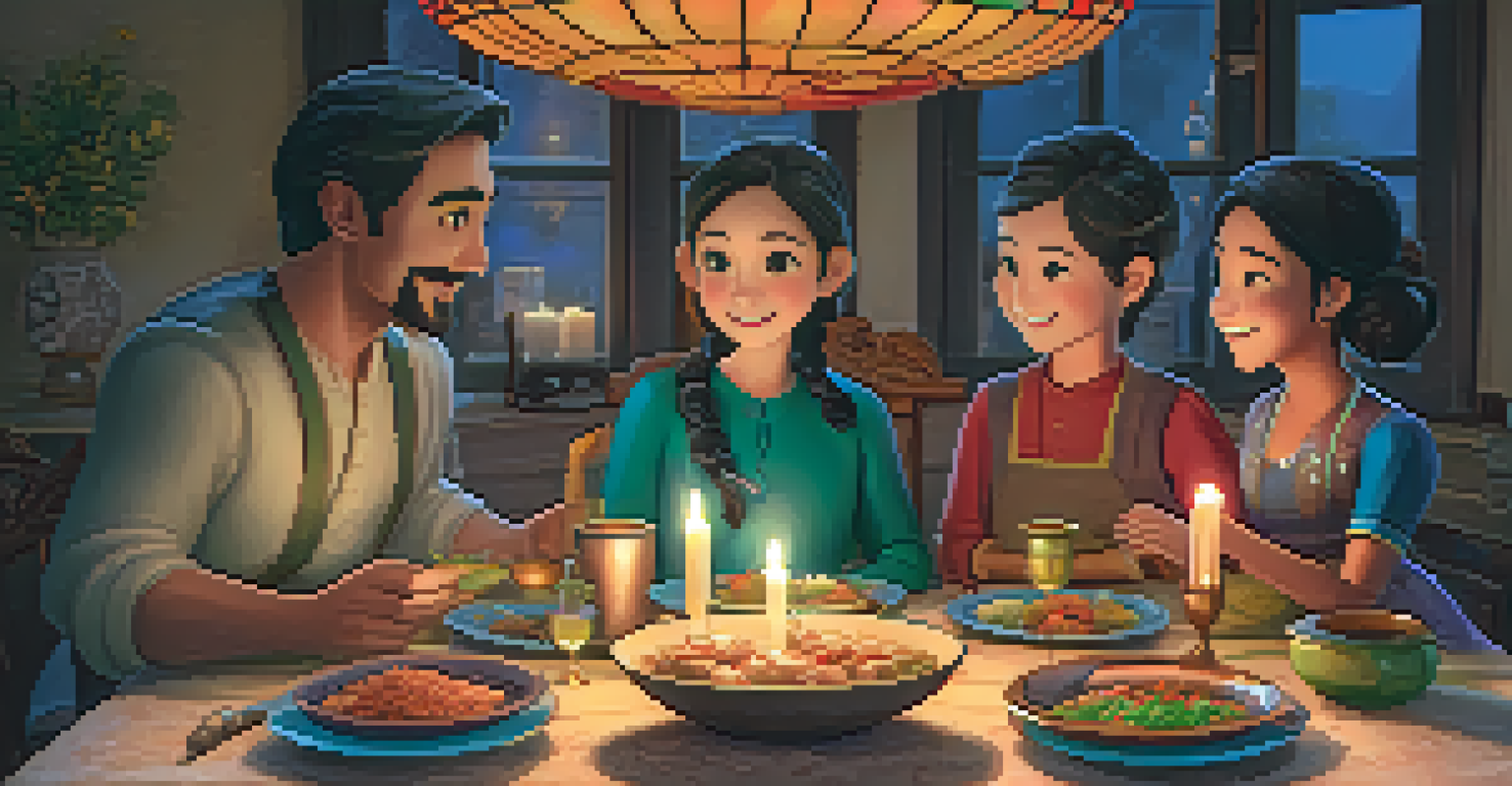The Significance of Storytelling in Animated Films

Understanding the Essence of Storytelling
Storytelling is the backbone of any narrative, acting as the thread that weaves characters and events together. In animated films, this essence becomes even more pronounced, as visuals are combined with storytelling to convey emotions and messages. Think of it as the difference between simply showing a beautiful painting and telling the story behind it; the latter adds depth and meaning.
Storytelling is the most powerful way to put ideas into the world today.
At its core, storytelling engages audiences, inviting them to connect with characters on a personal level. When viewers can relate to a character’s struggles or triumphs, it creates a bond that enhances their overall experience. In animated films, where characters often exhibit exaggerated traits, this connection can be even more powerful, drawing viewers into fantastical worlds while still resonating with real-life emotions.
The art of storytelling in animation is not just about entertainment; it’s a vehicle for conveying messages about life, love, and morality. For instance, films like 'Inside Out' beautifully illustrate complex emotions through relatable characters, making the abstract concepts more accessible to viewers of all ages. This blend of storytelling and animation creates an impactful experience that lingers long after the credits roll.
Characters: The Heart of Animated Storytelling
Characters are the lifeblood of any animated film, and effective storytelling brings them to life in vibrant ways. Well-crafted characters, with their unique traits and arcs, allow audiences to invest emotionally in their journeys. For example, take the lovable yet misunderstood creature from 'Monsters, Inc.'; his transformation from a scary monster to a caring friend showcases the power of character development.

In animated films, characters often embody specific traits or struggles that resonate with the audience. This relatability invites viewers to see parts of themselves in these characters, fostering empathy and understanding. When viewers cheer for a character’s success or mourn their failures, it reinforces the importance of storytelling as a means of connecting diverse audiences.
Storytelling Connects Audiences
Effective storytelling in animated films fosters emotional connections between viewers and characters, enhancing their overall experience.
Moreover, compelling characters can drive the narrative forward, creating tension and conflict that keep viewers engaged. Animated films like 'Zootopia' use character dynamics to explore themes of prejudice and acceptance, illustrating how storytelling can address real-world issues. Through their journeys, these characters not only entertain but also educate, making storytelling a powerful tool for social commentary.
The Role of Emotion in Animated Storytelling
Emotion is a critical component of storytelling, particularly in the realm of animated films. The ability to provoke feelings through visual artistry and narrative structure is what sets great animated movies apart. Whether it's a heartwarming moment or a gut-wrenching scene, emotional storytelling captures the audience's attention and elicits a strong response.
Animation can explain whatever the mind of man can conceive.
For instance, films like 'Coco' masterfully intertwine themes of family and remembrance, evoking a deep sense of nostalgia and connection. The emotional beats of the story are heightened by the stunning animation, creating a multi-sensory experience that resonates with viewers. This emotional depth is crucial, as it transforms a simple story into a memorable experience.
Furthermore, emotional storytelling in animation has the unique ability to bridge generational gaps. Children and adults alike can find common ground through shared feelings, making animated films a family favorite. This universality emphasizes the power of storytelling to communicate complex emotions in a way that is engaging and accessible to everyone.
Visual Storytelling: Animation's Unique Strength
Animation is inherently a visual medium, allowing storytellers to craft narratives that may be impossible in live action. The freedom to create fantastical worlds and characters enables a form of storytelling that captures imaginations. For instance, in 'Spirited Away', the vibrant visuals enhance the narrative, immersing viewers in a dreamlike adventure that feels both magical and profound.
Visual storytelling also allows for the use of symbolism and metaphor, which can convey deeper meanings without relying heavily on dialogue. The imagery in animated films often speaks volumes, creating layers of interpretation for audiences to explore. This artistic expression enriches the storytelling experience, making it a feast for both the eyes and the mind.
Characters Drive Engagement
Well-crafted characters in animation invite audiences to invest emotionally in their journeys, reinforcing the importance of relatability.
Moreover, the combination of visuals and sound design in animated films elevates the storytelling experience. Soundtracks and sound effects can evoke emotions that reinforce the narrative, creating a cohesive atmosphere. This synergy between visuals and audio is a hallmark of successful animated films, showcasing how storytelling transcends mere words.
Cultural Significance of Animated Storytelling
Animated films often serve as cultural mirrors, reflecting societal values, beliefs, and issues through storytelling. They can provide insight into different cultures and perspectives, fostering understanding and empathy among diverse audiences. For instance, films like 'Mulan' and 'Moana' introduce viewers to rich cultural narratives, illustrating the importance of heritage and identity.
Through storytelling, animated films can challenge stereotypes and promote inclusivity. By featuring characters from various backgrounds and experiences, these films encourage viewers to embrace diversity and celebrate differences. This cultural significance not only enriches the animation but also empowers audiences to engage with broader social issues.
Additionally, animated storytelling can preserve traditional tales and folklore, ensuring that they are passed down through generations. Films that adapt cultural myths introduce these stories to new audiences, keeping them alive in a modern context. This blend of tradition and innovation in storytelling highlights the timeless relevance of animated films.
The Impact of Technology on Animated Storytelling
Advancements in technology have revolutionized the way stories are told in animated films. From CGI to motion capture, these innovations offer creators new tools to enhance storytelling. This technological evolution allows for greater creativity and complexity in character design, movement, and environment, resulting in visually stunning narratives.
For example, the use of 3D animation in films like 'Toy Story' has transformed the landscape of animated storytelling, paving the way for richer, more immersive experiences. With technology, animators can portray emotions and actions in ways that were previously unimaginable, deepening the audience's connection to the characters. This evolution demonstrates how storytelling can adapt and grow with the times.
Technology Enhances Animation
Advancements in technology have revolutionized animated storytelling, allowing for greater creativity and deeper audience connections.
Moreover, technology has expanded the accessibility of animated films, allowing diverse voices to share their stories. Platforms like streaming services provide a space for independent animators to showcase unique narratives that might not have been possible in traditional cinema. This democratization of storytelling enriches the animation landscape, offering audiences a broader range of perspectives and experiences.
Storytelling: The Future of Animated Films
The future of animated films is bright, with storytelling at its core driving innovation and creativity. As audiences continue to seek diverse narratives and representation, animators are challenged to push boundaries and explore new themes. This evolution in storytelling will likely lead to richer, more inclusive narratives that resonate with a global audience.
In addition, the rise of interactive storytelling in animation presents exciting possibilities. Viewers may soon have the opportunity to influence the narrative direction, creating a more personalized experience. This shift could redefine the relationship between audiences and storytellers, making the act of watching animated films even more engaging.

Ultimately, the significance of storytelling in animated films will continue to shape the industry, inspiring both creators and audiences alike. As we navigate this dynamic landscape, one thing remains clear: a well-told story has the power to connect us all, transcending boundaries and enriching our lives through the magic of animation.